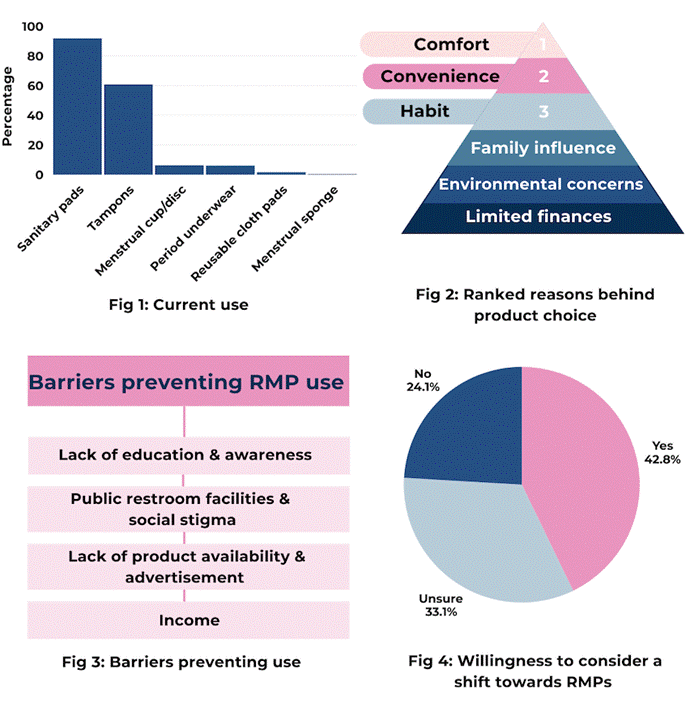On any given day, over 300 million individuals worldwide menstruate and rely on menstrual products to collect or absorb their monthly fluid. The vast majority use disposable menstrual products. This widespread use of single-use menstrual products raises significant concerns: it contributes to environmental degradation and pollution due to their plastic content, poses potential health risks from exposure to harmful chemicals, and exacerbates period poverty because of the ongoing costs of these products.
Under the supervision of Prof. Elisabeth Conrad, my dissertation entitled Investigating use of sustainable menstrual products among university students in Malta explored students’ attitudes and behaviours towards reusable menstrual products. Recognised for its relevance to consumers, practical applicability, and assessment of impacts on Maltese consumers, this study was awarded the Consumers’ Association Malta Outstanding Dissertation Award.
In this dissertation, key barriers to the adoption of reusable menstrual products were identified, and insights and potential solutions to help address them were provided. A sequential mixed-methods approach combined a survey of 386 university students with qualitative data from focus groups.This methodology offered a comprehensive understanding of the factors influencing menstruators’ purchasing decisions and the barriers to adopting reusable menstrual products.
The barriers to adopting reusable menstrual products
Disposable menstrual products – specifically sanitary pads and tampons – were the most commonly used among survey participants, with comfort, convenience, and habit cited as the top reasons for their use. No significant evidence of period poverty was found or linked to using inexpensive, single-use products. However, despite increasing global interest in sustainability trends, the use of reusable menstrual products remained low. Focus group discussions revealed that menstrual product choices, including reusable options, were strongly influenced by peers and family members.

Four significant hurdles were revealed:
- The survey results identified a lack of education and awareness as the primary barrier to adopting reusable menstrual products. Many students were unfamiliar with how to use, clean, and maintain reusable products, particularly menstrual cups and menstrual discs. Focus group discussions highlighted the influential role of social media and interpersonal relationships in increasing awareness, while educational systems provided little to no information. Tackling this gap in awareness is crucial in increasing uptake. Educational institutions should improve their curricula to include information on sustainable menstrual options, rather than focusing solely on disposable options.
- Inadequate restroom facilities and social stigma hinder the uptake of reusable menstrual products. Participants emphasised the absence of private washing areas in university restrooms, noting that using shared sinks made washing reusable products uncomfortable. These findings underline the need to improve restroom facilities to normalise sustainable menstruation practices.
- Limited product availability and a lack of advertisement further hinder the adoption of reusable menstrual products. Focus group participants mentioned that grocery stores, where one usually finds sanitary pads and tampons, should also sell sustainable alternatives. Furthermore, both survey and focus group participants noted the need for increased advertising to make reusable products more mainstream and to raise awareness of sustainable options.
- Lastly, almost half of the survey participants (42.7%) expressed a willingness to consider switching to reusable menstrual products,with a further 32.9% indicating uncertainty. Willingness is likely to increase if the aforementioned barriers are addressed. Therefore, through education, improved restroom facilities, and increased product availability and accessibility, sustainable menstruation can become normalised, benefiting both individuals and the environment.
Ultimately, identifying these barriers is crucial to understanding the dynamics behind purchasing decisions and developing effective strategies to increase the adoption of sustainable menstrual products.Future research should focus on the attitudes and behaviours of menstruators under the age of 18 to evaluate if they face different barriers to trying reusable menstrual products, and to assess the extent of their awareness and education on these products. An experimental study could subsequently test whether increased education leads to higher adoption rates.
Applications and societal value
This research holds significant societal value and the potential to make a meaningful impact by providing practical recommendations to increase the adoption of sustainable menstruation practices. The findings can help inform and guide policymakers in developing initiatives that promote sustainable menstrual practices by addressing some of the barriers that menstruators face. Additionally, tackling these barriers can reduce environmental harm, minimise health risks, and alleviate monthly financial burdens.
Read the full dissertation here.
Findings illustrated throughout Izabella Apostolov’s study investigating the use of sustainable menstrual products among university students in Malta. (Figures courtesy of Izabella Apostolov)
The following article by Izabella Apostolov features in Issue 47: Disciplines of THINK Magazine, the official research magazine of the University of Malta. For more articles from the edition, pick up a copy on Campus or read here. (Republished courtesy of THINK).










